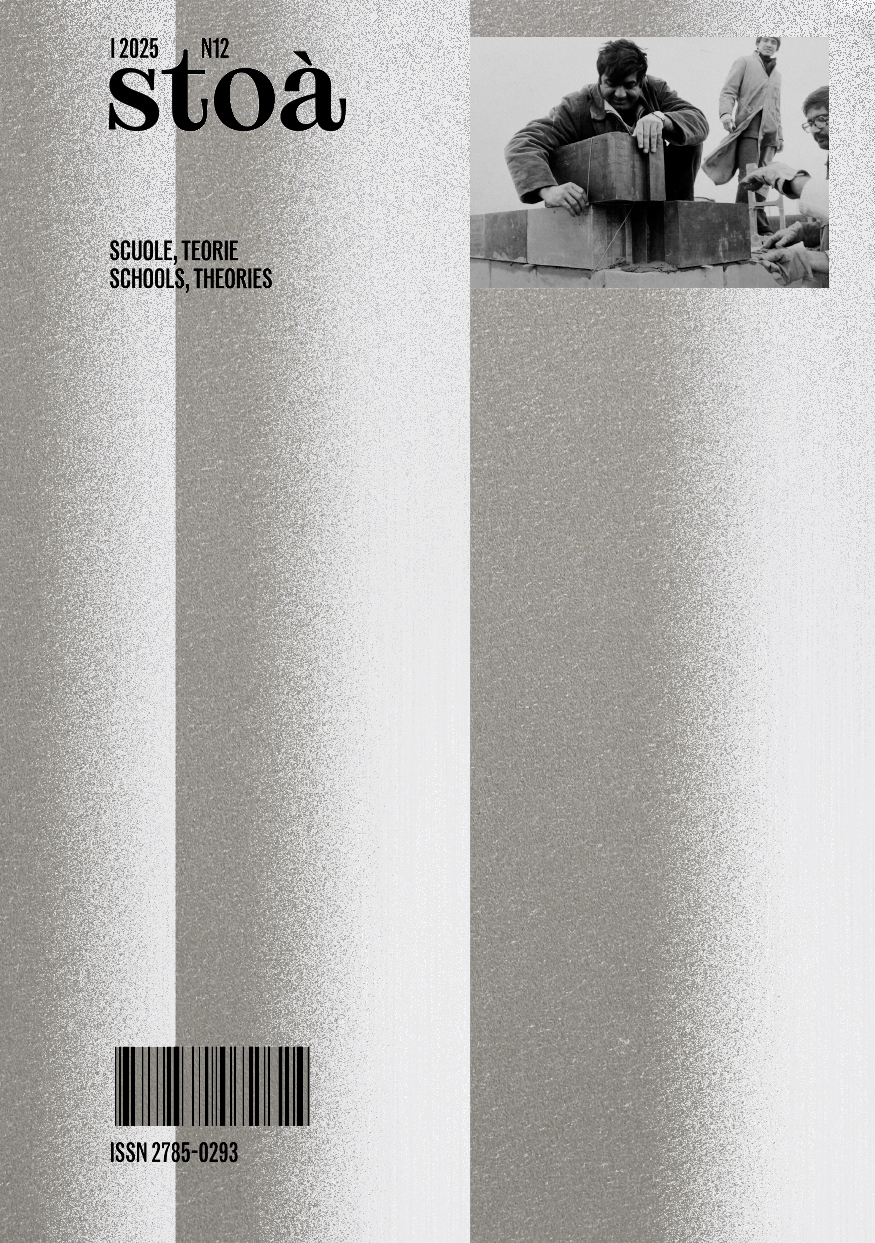︎︎︎ Issue 12

stoà 12 SCUOLE, TEORIE / SCHOOLS, THEORIES
Anno V, 1/3, Inverno 2025
ISSN 2785-0293
ISBN 978-88-32072-62-4
Insegnare a pensare architettura è una delle più difficili sfide del mestiere di chi progetta la pedagogia per il progetto. Nella storia dell’insegnamento dell’architettura ricorrono numerosi casi di scuole nelle quali spesso il pensiero si è elevato oltre un orizzonte immediato, dove una comunità di persone si è posta degli interrogativi sul senso di quel lavoro che è l’insegnamento, che nella sua essenza è un’interrogazione continua, grazie anche a una dialettica fatta attraverso l’esistenza e l’espressione di posizioni eterogenee. Teorie e visioni del mondo in grado di determinare un particolare momento di svolta o di scarto rispetto allo status quo perpetuato attraverso la ripetizione o la messa in crisi di modi di fare stratificati nel tempo e nei luoghi, che hanno segnato in modo profondo scuole, docenti e studenti, ovvero la società e le maniere di costruire realtà, spazi e progetti culturali.
Teaching how to think architecture is one of the most challenging tasks in the profession of those who design the pedagogy of the project. Throughout the history of archi- tectural education, numerous examples can be found of schools where thought has often transcended immediate horizons, fostering a community of individuals who have questioned the meaning of the teaching endeavor. At its core, teaching is a continuous inquiry, enriched by a dialectic shaped through the coexistence and expres- sion of heterogeneous perspectives. Theories and worldviews capable of marking pivotal moments or shifts away from the status quo – maintained through repetition or the critical reevaluation of long-established practices rooted in time and place – have pro- foundly influenced schools, educators, and students alike. These dynamics, in turn, have shaped society and the ways of constructing realities, spaces, and cultural projects.
︎︎︎Get a copy
︎︎︎Issues
︎︎︎SCUOLE, TEORIE / SCHOOLS, THEORIES a cura di/edited by Marianna Ascolese, Tommaso Brighenti, Alberto Calderoni
Coordinate
︎︎︎Tensioni collettive / Collective Tension
Alberto Calderoni
︎︎︎A cuore aperto / With an Open Heart
Marianna Ascolese, Tommaso Brighenti
Posizioni
︎︎︎II paesaggio composito della teoria architettonica / The Composite Landscape of Architectural Theory
Alberto Ferlenga
︎︎︎Architettura, l'arte di costruire significati / Architecture, the Art of the Constructuction of Meaning
Anna Braghini, Fernando Pérez Oyarzún
Ideario
︎︎︎Esperimenti di pedagogia della forma / Exploring the Pedagogy of Form
Aleksa Korolija
Rapporti
︎︎︎Kay Fisker e il corso Boligbyggeri (1924-1955) / Kay Fisker and the Boligbyggeri Course (1924-1955)
Chiara Monterumisi
︎︎︎II secolo breve di Herman Hertzberger / The Short Twentieth Century of Herman Hertzberger
Stefano Corbo
︎︎︎Tange Lab, un metodo di lavoro / Tange Lab, a Way to Work
Giona Carlotto
︎︎︎Come insegnava l'altra metà / How the Other Half Taught
Leonie Bunte, Andrea Alberto Dutto, Vikram Bhatt
Tracce
︎︎︎La Escuelita abierta
Santiago Gomes
︎︎︎ Un presidio democratico per l'architettura / A Democratic Laboratory for Architecture
Marella Santangelo
Coordinate
︎︎︎Tensioni collettive / Collective Tension
Alberto Calderoni
︎︎︎A cuore aperto / With an Open Heart
Marianna Ascolese, Tommaso Brighenti
Posizioni
︎︎︎II paesaggio composito della teoria architettonica / The Composite Landscape of Architectural Theory
Alberto Ferlenga
︎︎︎Architettura, l'arte di costruire significati / Architecture, the Art of the Constructuction of Meaning
Anna Braghini, Fernando Pérez Oyarzún
Ideario
︎︎︎Esperimenti di pedagogia della forma / Exploring the Pedagogy of Form
Aleksa Korolija
Rapporti
︎︎︎Kay Fisker e il corso Boligbyggeri (1924-1955) / Kay Fisker and the Boligbyggeri Course (1924-1955)
Chiara Monterumisi
︎︎︎II secolo breve di Herman Hertzberger / The Short Twentieth Century of Herman Hertzberger
Stefano Corbo
︎︎︎Tange Lab, un metodo di lavoro / Tange Lab, a Way to Work
Giona Carlotto
︎︎︎Come insegnava l'altra metà / How the Other Half Taught
Leonie Bunte, Andrea Alberto Dutto, Vikram Bhatt
Tracce
︎︎︎La Escuelita abierta
Santiago Gomes
︎︎︎ Un presidio democratico per l'architettura / A Democratic Laboratory for Architecture
Marella Santangelo
